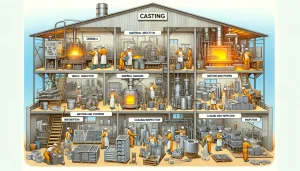Introduction to Casting
Casting is an age-old yet pivotal manufacturing process involving the melting of metal and pouring it into a pre-made mold, where it cools and forms a specific shape. This process was crucial for ancient civilizations and continues to play a significant role in today’s manufacturing industries.
Definition and Significance of Casting
Casting involves heating metal to a liquid state and pouring it into a mold, where it cools and solidifies into the desired shape. This process enables the production of complex parts used extensively in automotive, aerospace, and construction industries.
The Historical Context of Casting
The history of casting traces back over 6000 years. Ancient civilizations, including the Egyptians, Chinese, and Romans, utilized casting technology to create art, weapons, and tools.
The Casting Process
The casting process encompasses several steps: design and prototyping, material selection, mold making, melting and pouring, and cleaning and inspection. Each step is crucial to the outcome.

Design and Prototyping
The design phase marks the beginning of the casting process, considering the product’s use, shape, and dimensions. Prototyping transforms design concepts into physical models.
Material Selection
Choosing the right casting material is key to determining product performance. Common casting materials include iron, steel, aluminum, and copper, each selected based on the product’s intended use and required properties.
Mold Making
Mold making is a critical step where a negative of the desired shape is created. Molds can be made from various materials, including sand, metal, or ceramic, depending on the casting process and material.
Melting and Pouring
Melting the chosen metal and pouring it into the mold is a delicate process that requires precise temperature control to ensure the metal fills the mold completely and solidifies correctly.
Cleaning and Inspection
After the metal has cooled and solidified, the cast part is removed from the mold and undergoes cleaning to remove any excess material. Inspection ensures the part meets all specifications and quality standards.
Materials Used in Casting
The choice of material affects the casting’s properties and application. Factors influencing material choice include the casting’s intended use, required strength, and thermal properties.
Trends in Casting Technology
Innovations in casting technology focus on improving efficiency, precision, and environmental sustainability. New technologies and practices are continually emerging, reshaping the casting industry.
Conclusion
Casting remains a fundamental manufacturing process, integral to various industries. Its evolution continues, driven by technological advancements and a growing emphasis on sustainability.
Frequently Asked Questions
-
What are the most common materials used in casting?
- Iron, steel, aluminum, and copper are among the most commonly used materials in casting, chosen for their unique properties and applications.
-
What are the biggest challenges in the casting process?
- Challenges include controlling the quality of the cast, managing the costs of materials and processes, and minimizing environmental impact.
-
What are some emerging technologies in casting?
- Advances include 3D printing for molds, automation in pouring and cleaning, and environmentally friendly materials and processes.
-
How can the quality of cast products be determined?
- Quality is assessed through inspections, testing for mechanical properties, and ensuring the cast meets all design specifications.
-
What are some sustainable practices in casting?
- Sustainable practices include recycling materials, using energy-efficient processes, and reducing waste and emissions.
